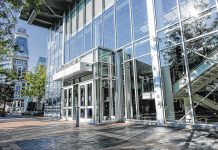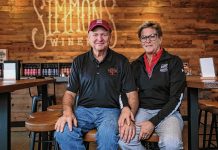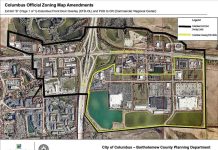The Columbus of the future will build upon the city as people know it today, panelists said.
Five of them shared their perspectives of what lies ahead for Columbus in the final presentation of a three-part lecture series focusing on the city’s past, present and future. The program, conducted Thursday night at the Columbus Learning Center, drew more than 50 people.
How Columbus ends up in five, 10 or even 20 years is dependent on having good leaders in place, said Mary Ferdon, executive director of administration and community development with the city of Columbus. That includes elected officials and community leaders, Ferdon said.
Columbus has a history of shaping its own future rather than wait and see what develops on its own, in part because of strong leaders.
[sc:text-divider text-divider-title=”Story continues below gallery” ]
Focus 2000 and Vision 20/20 were visioning projects under former mayors Fred Armstrong and Robert Stewart that brought projects such as The Cole apartments, the Jackson Street parking garage and reconstruction of The Commons to fruition, Ferdon said.
The next strategic plan, known as Envision Columbus, has recently launched and will focus on downtown Columbus, she said.
Many of the city’s most important developments have been the result of public-private partnerships — with taxpayer and private dollars combining to initiate progress.
One of the city’s biggest and most recent public-private partnerships is the $30 million west-side railroad overpass project at the State Road 46/State Road 11 intersection, expected to begin next year. It is being constructed to mitigate an increase in railroad traffic through Columbus.
The state has agreed to pick up $15 million of the cost, while other partners also have chipped in — the city, Bartholomew County, Cummins Inc., and the Louisville & Indiana and CSX railroads.
Also potentially on the near horizon is a proposed $8.6 million Columbus Riverfront project, meant to draw more visitors to the city and increase the quality of life for residents.
City officials have said they expect to fund the Riverfront project through a combination of tax increment financing funds, state and federal grants and public/private partnerships.
Without predicting what the next public-private partnership might be, Ferdon said the concept will be important to continue.
Matters beyond the city’s control will also frame its future. That includes the proposed Riverfront project, which requires permits from state and federal agencies.
“Regulations will certainly affect how we move forward,” Ferdon said.
Also challenging to control are serious social issues such as the opioid epidemic, which has significantly impacted Columbus and the nation as a whole, Ferdon said.
Business environment
Partnerships are also key for the future of Columbus area businesses, who have an estimated 1,400 unfilled jobs.
How well Columbus companies prosper into the future will depend on workforce development efforts by groups such as the Community Education Coalition, a bridge between education and employers, said Cindy Frey, president of the Columbus Area Chamber of Commerce.
The coalition is working to ensure students are successful coming out of high school with training, certificates and degrees that feed directly into high-demand jobs in the area.
The Columbus Area Economic Growth Council and the Columbus Young Professionals are also part of the talent-attraction picture, Frey said.
With 600-plus members, the chamber and its own programs will continue to play an important role in Columbus’ future, Frey said. As businesses thrive, the community grows, she said.
Like other groups, the chamber is also dialed in on how Columbus businesses can develop, attract and retain workers — while making stronger business connections with one another, she said.
Cummins Inc., the city’s largest employer, sees a strong future in electrification, said Andy Pajakowski, director of the company’s business development and electrification.
The company is focusing its electrification efforts in progressive areas at six locations in four countries — its home base of Columbus; Talent, Oregon; Greene, New York; Milton Keynes in the United Kingdom; Pune, India; and Beijing, China. When the markets are ready, the company is prepared to invest in the technology to help its customers meet their needs, Pajakowski said.
Other innovating, advancing technologies are coming in agriculture, said David Harrell, assistant professor of crop production at Ivy Tech Community College in Columbus. Entrepreneurs who invest in grape crops for wine and hop production for craft beer have the potential for strong payoffs, he said.
Role of culture
The city’s global architecture reputation, which took root 75 years ago, will continue to play an important part in the city’s future, said Richard McCoy, director of Landmark Columbus, an organization created in 2015 to help protect architecturally significant buildings in the city.
“The future of Columbus is based in our culture,” McCoy said. “It’s an extraordinary place with a lot of history.”
Last fall’s Exhibit Columbus exhibition, showcasing 18 temporary installations, put the city’s traditions and values on display for people to see, McCoy said.
When McCoy looks at contributions made to Exhibit Columbus by high school students, it bodes well for the future, he said.
Local high school seniors created “Between the Threads,” featuring 87 white vertical metal panels characterized by Rexlace string. The students’ work was just as good as or better than some of the other exhibits on display by more experienced teams, McCoy said.
“The future is tomorrow and we’re excited about it,” he said.
[sc:pullout-title pullout-title=”Key points from discussion” ][sc:pullout-text-begin]
City projects: Railroad overpass project at the State Road 46/State Road 11 and Columbus Riverfront are on the horizon.
Helping businesses: The Columbus Area Chamber of Commerce will continue its focus on helping develop, attract and retain workers.
Architecture: A Sept. 26-29 symposium, “Design, Community, and Progressive Preservation,” will be held in Columbus. The symposium “seeks to place the traditions and original vision of Columbus into a national perspective through presentations and dialogue between professionals and communities,” according to Exhibit Columbus.
Agriculture: Technological innovations are expected to continue; investments in wine grapes, hop production could produce strong returns.
Cummins Inc.: The Columbus-based employer, the city’s biggest, is focusing its efforts on electrification.
[sc:pullout-text-end]




